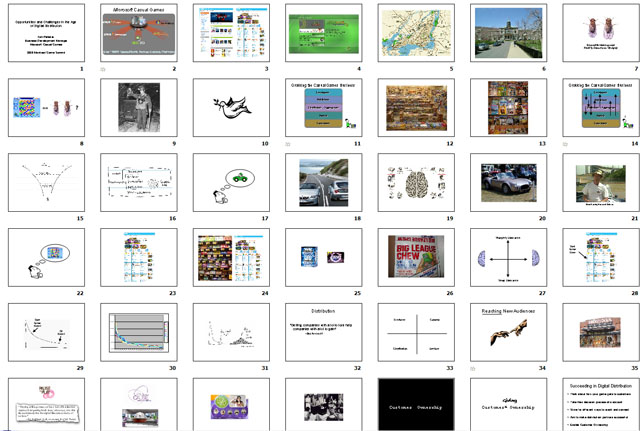As mentinoned in my previous post, I gave a presentation at MIGS06. I'll eventually post it (along with transcript) but I wanted to do a little mini-post-mortem on what I was trying to do with it and how well it worked.
I've given hundreds of presentations over my career in groups ranging from five to five hundred. Truth is, I've never been terribly pleased at the results of any of them. Some were atrocious, some were well received. At best, I'd say I've given a "b minus" level presentation. Something like the QoL talk I did at GDC 2005 was maybe an example of this. However, I've never given a *really* top notch talk.
Now, let's get this straight, I'm not saying I did this time either.
What I did know was that something had to change, and over the past year, it's been a background goal of mine to improve.
So, I'd had a 'dump and chase' idea (a hockey analogy: Lacking a plan/play, dump the puck over the blue line, chase it in after it, worry about a plan then) about a talk around Digital Distribution and I proposed it for the Montreal Summit. It got accepted and so the forcing function was there to work on the talk and use it to try and reach a new level of presentation skill.
I had 3 goals for the presentation:
- Compelling presentation style. People should be intrigued - rivetted, even - start to finish.
- No words. I am presenting, not powerpoint. Picture is worth a thousand words. (More on this later).
- Deliver one or more valuable calls-to-action that, while beneficial to my business and my employer, are honest and interesting to the listener, and don't come off as 'the microsoft pitch'.
I spent a long time bookmarking and filing things that might be relevant to the presentation when it came time to assemble it. Hundreds of clippings both digital and analog were stored away over the course of six to eight months. However, for the presentation style and form itself, I specifically drew inspiration from five places:
- Clint Hocking's 'Next: The Designer's Generation' talk from MIGS05. I blogged about it here. It moved me. It made fantastic use of imagery to both support and/or contrast the speaker's words. It had humor. It told stories. It delivered a powerful message. It in many ways was the amalgamation of 2 through 5 below. It was performance art.
- Dick Hardt's Identity 2.0 Presentation. Superbly scripted; rapid-fire presentation slides with single images or single words on each. Even background color is powerfully used. A barn-burner.
- Seth Godin's "All Marketers are Liars" talk at Google. Seth tells stories. Very human, very 'everyday' stories that audiences can connect with.
- Guy Kawasaki's Art of the Start talk from TiECon 2006. This is a good talk any time, but for this one in particular, Guy was on fire. In particular, I liked the use of humor, of analogy, and his handling of the 'handlers'.
- James Burke's ACM Siggraph 97 Presentation: Fantastic use of analogy and learning from history. There are some particular examples in digital distribution where I wanted to use this. Also like his occasional use of humor.
Having looked at #1 (and another of Clint's presentations) and #2, as well as a number of others following the same style, it was obvious they'd been highly scripted. So that was where I started. I looked at a number of presentations along those lines to guess how long a presentation of that length had to be. Some had online versions on which I could do word and slide counts. Answer: 100 words/minute for someone of my speaking cadence. This would result in a 6000 word presentation that I would dry run in one hour and deliver live in 45-50 minutes (live always goes faster). This turned out to be a surprisingly accurate estimate.
On the slide front, the one-picture-per slide seem to average 1 slide per minute. This generally worked out to 3 or 4 slides the presenter would fire through rapidly, say 10 seconds each, and then a slide the presenter might spend four minutes on, like a diagram or something else that illustrated a process or concept, whereas the rapidfire images were just supportive imagery. The extreme of this would be #2 from above, which averaged 40 slides PER MINUTE. I counted. That's over 500 slides in his pitch of 15 minutes or so.
So, using these guidelines, I laid out what I wanted to say in bullet form. From there, I thought aobut some interesting analogies and anecdotes I could use to tell stories around this. Then I scripted it out. I turned it into roughly a 5000 word script. I did this over the course of weeks, but with bits and pieces done out of order. I had certain stories or sections that I tried dry-running on their own to see if they felt right. Eventually though (very last minute - more on this later), I had a whole script.
From there I dry ran it - without slides - a handful of times. I changed order around, threw out some pieces, added others. Once I had something I was happy with, I assembled slides as supportive material. I'd been working on bits and pieces already done, but the point here is the first time a start-to-finish Powerpoint deck was done was AFTER I'd dry run the presentation and was roughly pleased with it.
While I cant post it yet, this reduced images should at least give you a feel for the image-heavy, minimalist feel of the deck:

Now, once I did that, I dry-ran it again. And realized I still wasn't pleased with some portions of it. Now this was 1am the night before the presentation (10 hours to go), so I had a choice. Muck with it in the morning, or do it right. I chose the latter and pulled an all-nighter, rearranging things and dry running it another 4 times or so before the presentation (at a full hour per dry run, it adds up).
The next day I delivered the presentation and it went off pretty well. I'd give myself a B+, maybe A-, but not better than that. That's not bad considering I was moving to a new format & style that I was very uncomfortable with.
So what happened?
On the plus side, the format worked, and more importantly, was a forcing function for me to have an extremely well rehearsed presentation. No hiding behind bullet points. The analogies and illustrative imagery made for an entertaining presentation and I could tell people were engaged. I had lots of positive feedback after the talk.
On the minus side, I left far too much till the last minute. Aside from the sure-to-get-my-wrist-slapped-move of not being able to run in by our PR folks for approval, it let to me pulling the all-nighter, which meant I wasn't as sharp a presenter as I could have been - espresso treatment aside. Also, I had it pointed out to me that I'd have done well to follow the "tell them what you are going to tell them" rule at the start of the presentation, especially when you are going to go off on 'anecdotal tangents'. Finally, while some things might serve well as analogies, as someone from MS I need to keep in mind that these can be pulled out to serve as headlines where they can be construed differently (google 'pallister' and 'fruit flies' to see what I'm talking about).
Overall, I'm still pleased. I'll definitely continue with the new approach, especially given teh dinner discussion I had with some collegues... which will be the subject of my next post.



